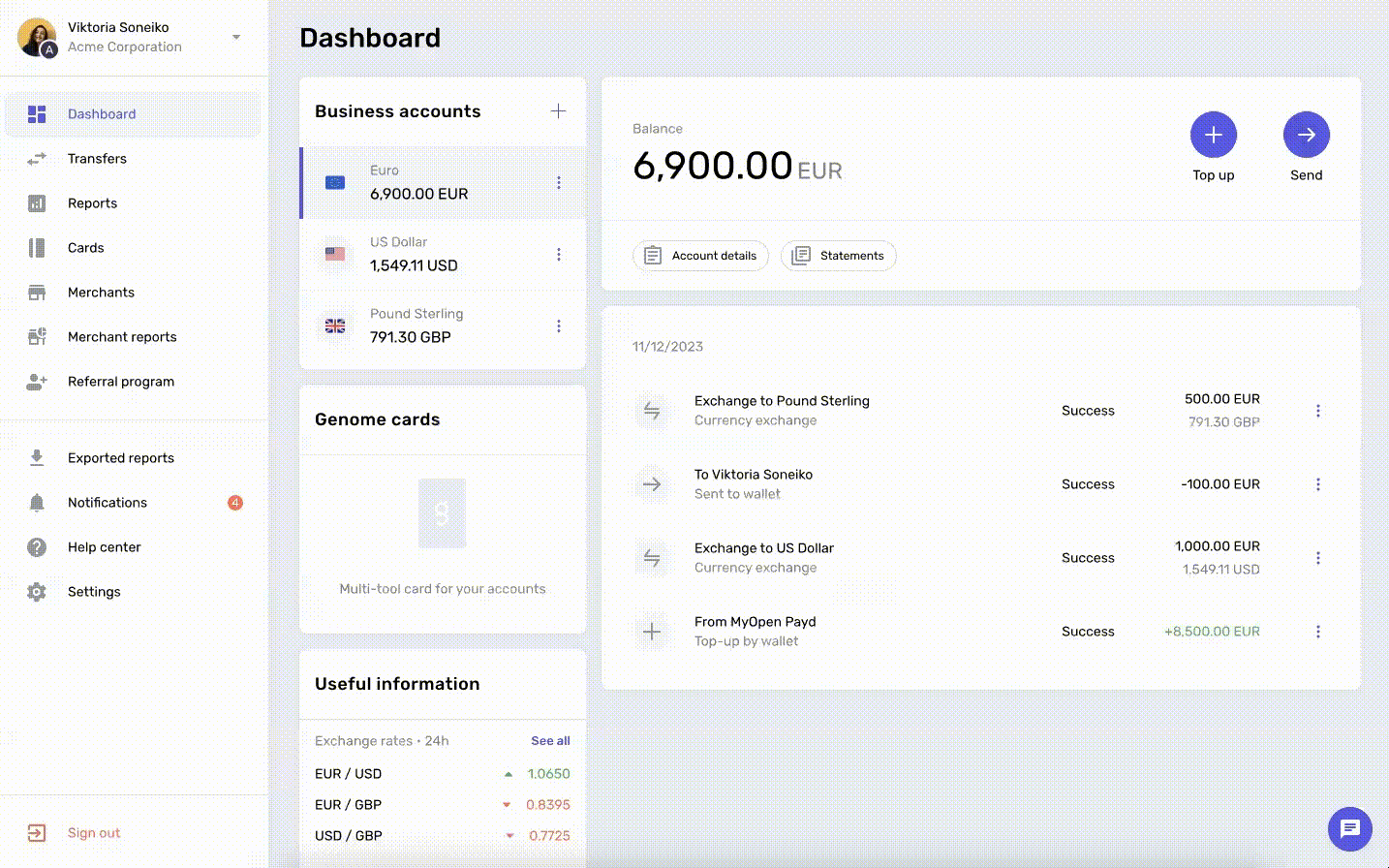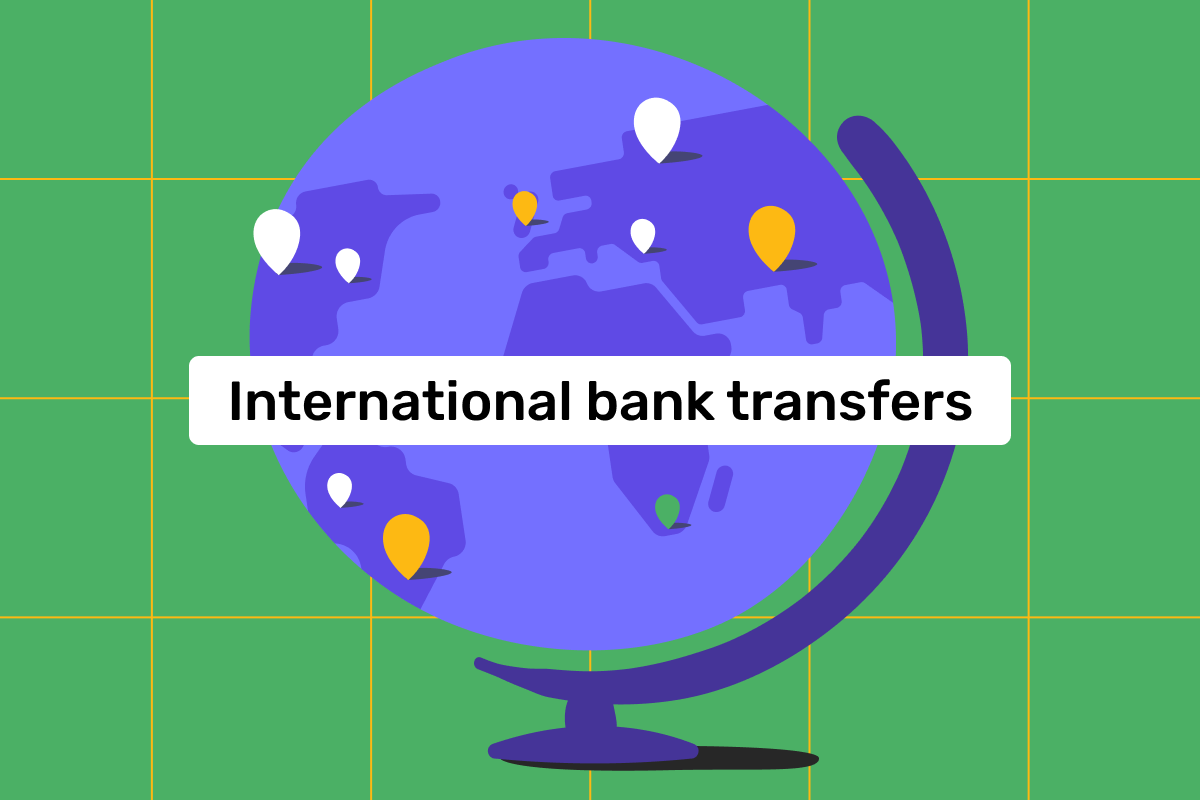The article was updated on 11.07.2024
Money matters are essential to many people and companies’ daily routines. And sometimes, they need to deal with international money transfers.
Different types of international transfers have rules and features that can sometimes be hard to follow. Genome’s team is here to help! Find out how international money transfers work, how long international bank transfers take, and how to send international payments using Genome.
What is an international bank transfer?
A money transfer is a process of sending money electronically between two financial institutions, bank accounts, etc.
Consequently, international bank transfers occur when you send money to a person or company in a different country. It is what differentiates them from domestic transfers, which are money transfers between the payee and beneficiary who live within the same country.
In most cases, the SWIFT messaging network is the most common way to send money abroad, as banks exchange information and not money when you make a transfer to someone else.
How international bank transfers work
An international money transfer can be a necessity for anyone, from companies sending money abroad to their contractors to a regular person making an international payment to a relative abroad. So, how do you send money abroad when you need to? Let’s review the whole process.
Choosing the right bank or service
First and foremost, you need to have an account at a bank or with an online banking service that provides international payment services. Usually, if financial institutions offer SWIFT transfers, it means they provide international bank transfer services.
Before you open an account for this purpose, make sure to check the list of countries available for international payments. Additionally, review the pricing for the international payment service to ensure that it’s worth your while.
Also, if you don’t normally need international payments but need to send money abroad as a one-time occurrence, you can use the services of a wire transfer company.
Wire transfer businesses provide international payment services in many ways. For instance, you can come to the wire transfer company’s branch in Tallinn and settle a cash transfer to your friend in Munich. Just ensure that the wire company also has a branch there – this way, the friend can visit them and receive the cash you have sent.
Some wire transfer companies allow you to send money via their website or even order an international money transfer on the phone.
Providing recipient information
Once your account is up and running, you will need to get the account details of a beneficiary of your international payment – an individual or a company. Here’s the information you will need if you want to send an international payment online using Genome:
The recipient’s full name;
Their bank identifier code / SWIFT code or a sort code (for the UK);
Their international bank account number (IBAN) or just the account number;
The recipient’s bank account country;
The beneficiary’s country, city, and address (all optional).

Executing the transfer
So, how does the process of sending international payments work?
The payer fills out the information about the beneficiary we mentioned prior, the transfer amount, and the description.
The payer checks the information and clicks the Send button;
If the beneficiary’s bank accepts money transfers in a foreign currency (a different currency than that of the payer), the currency conversion process will take place. For instance, if the payer instructs a transfer in US dollars, and the receiver can only receive a payment in Polish zloty, the currency conversion will occur;
After currency conversion, the payer’s bank will route the transfer through intermediary banks using the SWIFT messaging system. Note that direct bank to bank transfer can occur as well if the international institutions are a part of one network;
The processing ends once the payer’s transfer reaches the recipient’s bank account.
The whole process can take 2–3 days on average, or longer, if the destination country is too far, there are too many correspondent banks, or if the international payment takes place during holidays.
Tracking the transfer
Financial institutions usually provide a tracking number or reference code once the payment is sent. Once the payment is sent, you can use this tracking number to learn the payment status. To do so, contact your bank and provide the number.
If you’re using Genome, you can check the final status of the international payment in your wallet — via both the web and app versions.
Open an account
in Genome online
Key components of international bank transfers
There are a couple of essential elements when sending money internationally. Let’s examine them individually to better understand the international payments process.
SWIFT/BIC codes
SWIFT/BIC codes are used to identify financial institutions to which the payments are sent. This bank code contains all the main information about the institution’s location, which is especially important when you send or receive money to a foreign bank.
IBANs
As with SWIFT codes, an international bank account number (IBAN) is used to make the transfer process to other countries more accurate. The IBAN identifies the beneficiary’s correct account number and contains all the necessary information.
Exchange rates
An exchange rate is the value at which the exchange of two different currencies occurs. You need to be mindful of the exchange rate when you make an international bank transfer, as multiple currencies can be involved. Usually, the exchange rate is displayed on the financial institution’s website when you make payments. Check Genome’s online calculator to see the exchange rate for EUR, USD, and GBP in seconds.
Transfer fees
Lastly, international bank transfers usually come with higher fees, as you must pay the currency exchange rate, intermediaries’ fees, general fees, and more. Make sure to check all the fees before sending payments.
Cost of international bank transfers
The price of sanding an international bank transfer consists of multiple charges:
Payment fees that are charged by the payer’s bank;
Exchange rate margins for currency conversion;
Intermediary bank fees for correspondent banks;
Payment fees that are charged by the beneficiary’s bank.
Those fees can be pretty hefty, so to avoid overspending, you need to compare the fees and rates of different financial institutions to select the best option.
Open an account
in Genome online
Timeframe for international bank transfers
International bank transfers involving the SWIFT system take an average of 2-5 business days to complete. The SWIFT network supports numerous currency types and cross-currency transfers.
The time frame of SWIFT transfer execution differs so much because it relies on different factors that take time:
Foreign currency conversions;
Different time zones;
Bank holiday and celebration days;
Intermediary banks involved.
For instance, if you’re sending funds within Europe, the process can take 1-2 business days. But, if your transfer is from the US to Asia, it can take up to 5 days to reach the receiver’s account.
If you worry about timeframes, you can try regional options and other ways to send money. For instance, SEPA (Single Euro Payments Area) payments are perfect for sending and receiving money between EU countries. Regular SEPA Credit Transfers are usually executed on the same day, while SEPA instant transfers take seconds!
Benefits of international bank transfers
If you use SWIFT transfers for your international payments, you get a lot of benefits, such as:
The international reach: SWIFT covers over 200 countries and territories, so you can send funds to almost any corner of the world;
It offers multiple currency options, ensuring that more people around the world have access to such transfers;
Such transfers are secure, as the financial industry heavily regulates them;
Currently, many financial institutions are a part of the SWIFT network, so you will likely have a lot of options when selecting a financial provider for this purpose.
Common challenges and solutions
Although international bank transfers are a great solution for overseas payments, they still have some downsides that need to be addressed.
Delays in transfer processing
As mentioned prior, when you make an international bank transfer, the delays in payments can reach up to several days. To avoid such situations, plan your transfers accordingly, check the timezone differences between you and the beneficiary, and don’t send transfers during banking holidays.
You can also set up recurring payments if you send money to someone regularly. This way, you won’t miss the payment deadlines and save time.
High transfer costs
Many charges are involved when you transfer money abroad. To lower the fees, check and compare the charges between different providers and select the most beneficial rates.
Check the exchange rate before sending the payment. If possible, send money in the same currency as the beneficiary’s.
Currency conversion issues
Currency exchange is very likely to happen when you make an international transfer. Not paying attention to the exchange rate can lead to very unfavorable charges.
If possible, use financial institutions that offer in-real-time exchange rate calculations, so you know exactly how much you will have to pay.
Security measures for international money transfers
Financial institutions ensure that you’re protected during international payments. For one, they follow strict security protocols imposed by the industry to prevent any breaches of sensitive data.
Additionally, many financial institutions, including Genome, implement two-factor authentication for outgoing payments to prevent anyone from the account owner from sending money.
The banks also use fraud-prevention tools to verify the identity of clients and avoid any misuse of their services.
Regulatory and legal considerations
As in the case of regular transfers, international bank transfers are heavily monitored to ensure security and compliance with international standards.
The main regulatory rules for safe payments abroad are:
Anti-Money Laundering (AML) regulations are used to prevent and detect money laundering.
Know your customer (KYC) mechanisms that allow you to verify the identity of a client.
Overall adherence to international financial laws and standards.
Tips for a smooth international money transfer
To avoid any issues with your international bank transfers, consider doing the following:
Always double-check all the information about the beneficiary and other payment details before sending a transfer;
Keep track of exchange rates and choose the best days to transfer your payment;
Use only trusted and secure financial institutions for international bank transfers;
Keep track of your payments – save bank statements.
Conclusion
International bank transfers are a safe and effective way to send money to different countries. If your business needs to send international payments, try Genome! We provide a variety of international transfer methods and a Visa Business debit card to complete your financial experience!
Open an account
in Genome online
FAQs
What information do I need to perform an international bank transfer?
You will need the name of the beneficiary, their SWIFT code/BIC, the recipient’s account number/IBAN, and the address of their bank (optional).
How long does an international bank transfer take?
Normally, international payments are processed within a few business days. Within the SWIFT network, the estimated arrival time for such transfers is 1-5 business days. A SWIFT payment can arrive on the same day it was sent if the countries are located close to each other.
What are the fees associated with international bank transfers?
The main fees for such transfers are charges that the payer’s and beneficiary’s financial institutions will charge, an exchange rate fee, and an intermediaries’ fee.
How can I track my international bank transfer?
To track the payments, you will need to contact your financial services provider and show it the tracking number assigned to your transfer.
What should I do if there is a problem with my transfer?
If there’s an issue with your international bank transfer you need to contact the support team of your financial institution.






